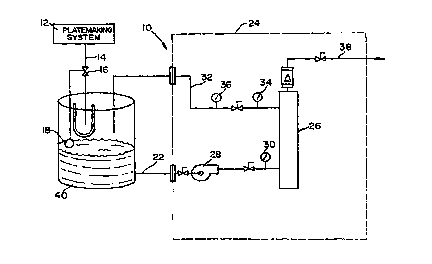Some of the information on this Web page has been provided by external sources. The Government of Canada is not responsible for the accuracy, reliability or currency of the information supplied by external sources. Users wishing to rely upon this information should consult directly with the source of the information. Content provided by external sources is not subject to official languages, privacy and accessibility requirements.
Any discrepancies in the text and image of the Claims and Abstract are due to differing posting times. Text of the Claims and Abstract are posted:
| (12) Patent Application: | (11) CA 2226966 |
|---|---|
| (54) English Title: | MAKING A PHOTOPOLYMER PRINTING PLATE |
| (54) French Title: | FABRICATION D'UNE PLAQUE D'IMPRESSION PORTANT UN PHOTOPOLYMERE |
| Status: | Deemed Abandoned and Beyond the Period of Reinstatement - Pending Response to Notice of Disregarded Communication |
| (51) International Patent Classification (IPC): |
|
|---|---|
| (72) Inventors : |
|
| (73) Owners : |
|
| (71) Applicants : |
|
| (74) Agent: | SMART & BIGGAR LP |
| (74) Associate agent: | |
| (45) Issued: | |
| (86) PCT Filing Date: | 1996-07-02 |
| (87) Open to Public Inspection: | 1997-01-30 |
| Availability of licence: | N/A |
| Dedicated to the Public: | N/A |
| (25) Language of filing: | English |
| Patent Cooperation Treaty (PCT): | Yes |
|---|---|
| (86) PCT Filing Number: | PCT/US1996/011185 |
| (87) International Publication Number: | WO 1997003382 |
| (85) National Entry: | 1998-01-13 |
| (30) Application Priority Data: | ||||||
|---|---|---|---|---|---|---|
|
A process of making a photopolymer printing plate includes steps of exposing a
photopolymer material to light that is applied in a predetermined image
pattern, washing the plate with a processing solution in order to cause
polymeric material from portions of the plate that are determined by the image
pattern to dissolve from the plate into the processing solution, and removing
the dissolved polymeric material from the processing solution on the molecular
level by ultrafiltration. The use of ultrafiltration permits the polymeric
material to be efficiently recovered without the need for conventional
recovery techniques such as distillation or flocculation, and allows reuse of
the filtrate to process additional photopolymer plates. A system (10) for
performing the process is also disclosed. The system is comprised of a plate
making system (12), and an ultrafiltration system (24) with an ultrafilter
(26) and a recirculation conduit (32).
L'invention concerne un procédé de fabrication d'une plaque d'impression portant un photopolymère, consistant à exposer le photopolymère à de la lumière, l'exposition se faisant suivant un motif image prédéterminé, à laver la plaque avec une solution de traitement pour faire en sorte que le matériau polymère des parties de la plaque délimitées par le motif image se dissolve dans la solution de traitement et à séparer le matériau polymère dissous de la solution de dissolution par ultrafiltration, à l'échelle moléculaire. L'utilisation de l'ultrafiltration permet de récupérer le polymère d'une manière efficace, sans avoir besoin de recourir à des techniques de récupération traditionnelles telles que la distillation ou la floculation, le filtrat étant utilisé à nouveau pour traiter d'autres plaques portant un photopolymère. L'invention concerne également un appareillage (10) permettant de mettre en oeuvre le procédé. L'appareillage comprend un système (12) pour fabriquer les plaques, un système d'ultrafiltration (24) avec un ultrafiltre (26) et une conduite (32) de recirculation.
Note: Claims are shown in the official language in which they were submitted.
Note: Descriptions are shown in the official language in which they were submitted.

2024-08-01:As part of the Next Generation Patents (NGP) transition, the Canadian Patents Database (CPD) now contains a more detailed Event History, which replicates the Event Log of our new back-office solution.
Please note that "Inactive:" events refers to events no longer in use in our new back-office solution.
For a clearer understanding of the status of the application/patent presented on this page, the site Disclaimer , as well as the definitions for Patent , Event History , Maintenance Fee and Payment History should be consulted.
| Description | Date |
|---|---|
| Inactive: IPC from MCD | 2006-03-12 |
| Inactive: IPC from MCD | 2006-03-12 |
| Application Not Reinstated by Deadline | 2001-07-03 |
| Time Limit for Reversal Expired | 2001-07-03 |
| Deemed Abandoned - Failure to Respond to Maintenance Fee Notice | 2000-07-04 |
| Inactive: First IPC assigned | 1998-04-30 |
| Classification Modified | 1998-04-30 |
| Inactive: IPC assigned | 1998-04-30 |
| Inactive: Notice - National entry - No RFE | 1998-04-09 |
| Application Received - PCT | 1998-04-06 |
| Application Published (Open to Public Inspection) | 1997-01-30 |
| Abandonment Date | Reason | Reinstatement Date |
|---|---|---|
| 2000-07-04 |
The last payment was received on 1999-07-02
Note : If the full payment has not been received on or before the date indicated, a further fee may be required which may be one of the following
Please refer to the CIPO Patent Fees web page to see all current fee amounts.
| Fee Type | Anniversary Year | Due Date | Paid Date |
|---|---|---|---|
| Basic national fee - standard | 1998-01-13 | ||
| Registration of a document | 1998-02-18 | ||
| MF (application, 2nd anniv.) - standard | 02 | 1998-07-02 | 1998-06-29 |
| MF (application, 3rd anniv.) - standard | 03 | 1999-07-02 | 1999-07-02 |
Note: Records showing the ownership history in alphabetical order.
| Current Owners on Record |
|---|
| POLYFIBRON TECHNOLOGIES, INC. |
| Past Owners on Record |
|---|
| DAN ROSEN |
| HOWARD B. BOYCE |
| LORI KLINGER |
| RAYMOND E. MARTIN |